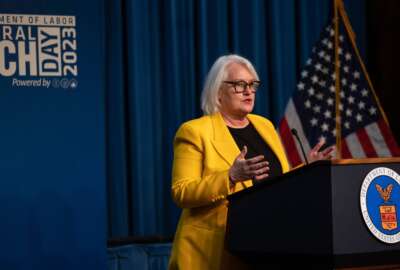Shared HR services provider looks after its own human resources
The Interior Department's business center, the IBC, has its own human resources and HR modernization to deal with.
The Interior Department’s business center — the IBC — provides shared payroll and other services to multiple federal agencies. It also has its own human resources and HR modernization to deal with. For an update, the Federal Drive with Tom Temin spoke to the center’s associate director for human resource, Julie Bednar.
Interview transcript:
Tom Temin Let’s talk about what you’re seeing in terms of customer agencies for the IBC. With respect to services and HR modernization, because so many agencies are doing HR modernization, how does that back up to the IBC? And how do you deal with it?
Julie Bednar For our customer agencies who we support, they rely on us to provide those services and systems that meet their business needs. And right now we’re keeping a close eye on all of those modernization activities across the various customer bases, as well as other stakeholder organizations to make sure that we’re leveraging all those best practices.
Tom Temin And should a given customer agency come up with a different way it wants to deliver one of the services that it’s using the IBC for, what do you have to do? How do you, I mean, are you able to customize to some degree for each of the customer agencies?
Julie Bednar So, as a shared service provider, we do leverage a shared footprint of technology and processes across our full customer base. And at the same time, we’re always interested in hearing how customers want to do business differently, or things that they’re leveraging to improve processes. So, we do want to hear from our customers when those opportunities arise. And even though we have a standard approach for delivering our shared services, when those best practices arise, we want to hear about them. And we we pivot, and we leverage those best practices as we get them from either our customer agencies or from other stakeholder organizations across the federal space.
Tom Temin Well, give us an example maybe of how something might have changed, because some agency decided, hey, this is a better way to deliver payroll, or whatever the case might be.
Julie Bednar Let’s think of an example here from a, I’m gonna call out our talent management system, for example. We have a talent management system called Fed Talent. And that is an integrated learning management, performance management and competency management system. We had a customer who wanted to leverage the information within that system to track telework arrangements. And we had not used the system to do that in the past. So, we listened to that customer, we figured out a way, and we made it work with that customer. And then hearing of that development, other customers are interested in that same kind of functionality. So, we’re sharing that with other customers across our base.
Tom Temin Did that require programming and actual development of new applications to run against the data? Or what did it take on your part?
Julie Bednar Because of the way that our talent management system is, it is configurable to allow that kind of functionality, so we didn’t have to really customize it. And we were able to configure some things within the system that made it work for the that new functionality.
Tom Temin What about the modernization that’s going on at the IBC? I think your own technology base is moving cloud word and so on, and what’s going on there?
Julie Bednar We do provide a full hire to retire suite of HR systems and services. So, across that full hire to retire suite, that information technology footprint is really broad. And there’s numerous different technologies, both hardware and software, and different life cycles across that. One of our integral systems there is the federal personnel and payroll system which is the only fully integrated HR system used by federal agencies today. And another system in our suite is a fully federalized time attendance system. So, for our HR systems modernization, we’re looking at different, at our current business processes to update for any outdated processes. First, we want to ensure our processes are updated, so we’re not applying new technologies to outdated processes. And then in addition, we strive to be a digital mindset first by putting the customer first and expanding our already strong customer-centric culture. So one of our IBC’s organizational values is customer focus. And we’re constantly looking to improve our customers experience through this business process analysis and reengineering. We’re going to identify requirements to use to explore future technology options. And then whatever those future technology options are, will be contingent upon many different factors with the primary factor being funding availability. Right now, I have limited resources. Um, so I’ll be constrained by whatever technology options that we can afford in the future.
Tom Temin We’re speaking with Julie Bednar. She’s associate director for human resources at the Interior Business Center, and the foundation cloud hosting services. You’re on the second round of that particular contract. How does that relate to the Interior Business Center native services that you are providing on a shared basis?
Julie Bednar We’re definitely keeping that cloud contract on our radar in terms of those technology options going forward. As we flesh out through this business process reengineering, which I described a minute ago, we flesh out those requirements, we line those requirements up against the options that are available in the marketplace. And then we look at what our funding limitations or availability are. And then we’ll be able to decide on which particular solutions we use going forward.
Tom Temin And with that on the horizon, and also the need to keep constantly evolving toward what customers want from IBC, talk about HR for the Interior Business Center itself.
Julie Bednar I do include our human resources operations systems with the other services that we provide across our federal agencies. We service over 30 federal agencies. And we apply the same shared processes across those federal agencies. And we partner very closely with our internal IBC. Hiring managers as well as our client agencies to ensure recruitment activities are achieving everyone’s mission needs. And that partnership to me is critical. I call that economies of skill. As a shared service provider, our collective experiences across dozens of client agencies provides us with a unique perspective that I think is broader than the singular focus of one agency. So as a result, the IBC team has a vast knowledge pool experiences that we leverage in delivering the best services to our customers, and then the client agencies know their missions the best. So working together, we develop the assessment criteria and leverage the legal and regulatory flexibilities available to cast that broad net to garner the best candidate pools for our hiring managers to select from. And then I think I mentioned our talent management system in an earlier example, which is called Fed Talent. And we’re leveraging that system to make sure that we can help our higher hiring managers and supervisors fill those performance and competency gaps for employees. So this one, that talent system houses data about an employee’s training history, and their regular employee performance achievements or areas that need improvement. And then any gaps can be addressed through assessing that data and through competency management. Like, for example, if there’s a critical performance factor, that the person is demonstrating either challenges with training or challenges with performance, the supervisor and employee can use the data that’s in that system and develop an individual development plan to close that gap for the internal workforce management.
Tom Temin And how is the talent management going within the IBC itself? How many people work there and how do you make sure you got the skills you need to do all of this?
Julie Bednar We have a little bit over 900 employees in the Interior Business Center. And again, through our close partnership with our hiring managers and our supervisors and strong focus on accountability and our organizational values. We’re making sure that all our employees are equipped for success. Our employees include our supervisors too, to make sure that they’re best handled to manage our workforce. And through that and leveraging the tools that I have described in our HR suite, we make sure that everybody has the information they need in order to do the best work possible.
Eric White Julie Bednar is associate director for human resources at the Interior Business Center.
Copyright © 2024 Federal News Network. All rights reserved. This website is not intended for users located within the European Economic Area.
Tom Temin is host of the Federal Drive and has been providing insight on federal technology and management issues for more than 30 years.
Follow @tteminWFED






